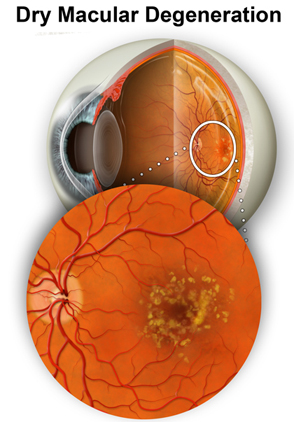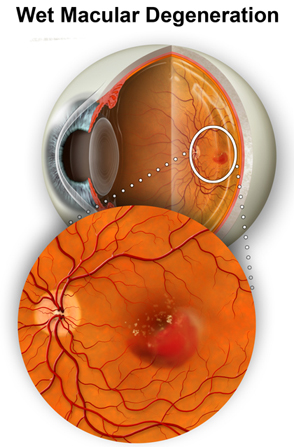Macular degeneration
Age related macular degeneration (AMD) is an eye disorder that damages the center of the retina, which is called the macula.
 The retina is the layer of tissue at the back of the inner eye. The macula is the part of the retina that provides us with a sharpest detailed vision and color perception. The retina is the layer of tissue at the back of the inner eye. The macula is the part of the retina that provides us with a sharpest detailed vision and color perception.
Two types of macular degeneration exist:
• Dry macular degeneration occurs when the small yellow deposits, called drusen, form under the macula. As these drusen increase in size and number, they create a blurriness and dim spots in the central vision of the eye.
• Wet macular degeneration occurs when brittle vessels under the macula break down and new abnormal and very fragile blood vessels start to grow. These vessels leak blood and fluid, which leads to damage of the macula. Even though the wet form occurs in only about 10% of people with macular degeneration, it causes most severe vision loss associated with the disease.
 Age related macular degeneration is most common in people over 60,
and in addition to heredity, other known risk factors are: Age related macular degeneration is most common in people over 60,
and in addition to heredity, other known risk factors are:
• White race
• Cigarette smoking
• High-fat diet
• Female gender
• Obesity
At first you may not have symptoms. As the disease progresses, your central vision becomes affected.
The most common symptom of dry AMD is blurred vision, trouble reading fine print, object distortion, and fading away of colors. As the disease becomes worse the blurred spot in the center of vision gradually gets larger and darker. In the later stages, you may not be able to recognize faces, lose the ability to read and drive a car.
The most frequent early symptom of wet macular degeneration is that straight lines appear distorted and wavy. You may also notice a small dark spot in the center of your vision that gradually gets larger. Central vision loss can occur very quickly. If this occurs, you urgently need evaluation by an ophthalmologist.
During the exam, the doctor will use drops to enlarge (dilate) your pupils, and a special lens to view your retina and optic nerve.
Other tests for macular degeneration may include:
• Fluorescein angiogram
• Optical Coherence Tomography (OCT)
No treatment exists for dry macular degeneration. However, a combination of vitamins, antioxidants, and zinc may slow the progression of the disease. This combination of vitamins is called the "AREDS" formula. The recommended supplements contain 500 milligrams of vitamin C, 400 International Units of beta-carotene, 80 milligrams of zinc, and 2 milligrams of copper. Smokers should not use beta-carotene due to increased risk of cancer.
Although there is no cure for wet AMD, treatments may include:
• Laser surgery -- a small beam of light destroys the abnormal blood vessels.
• Special medications that slow the formation of new blood vessels in the eye -- drugs such as bevacizumab (Avastin) and ranibizumab (Lucentis) are injected into the eye to stabilize or improve vision.
Low-vision aids (such as special lenses) and therapy can help you use the vision that you have more effectively, and improve your quality of life.
Most people with mild dry macular degeneration will not have disabling central vision loss. The wet form of macular degeneration on the other hand often leads to significant loss of vision. The disease though usually never causes complete blindness.
Although there is no known way to prevent macular degeneration, lifestyle factors can reduce your risk of developing the condition:
• Don't smoke
• Eat a healthy diet that is high in fruits and vegetables and low in animal fat
• Exercise regularly
• Maintain a healthy weight
See your eye care doctor regularly for dilated eye exams. |